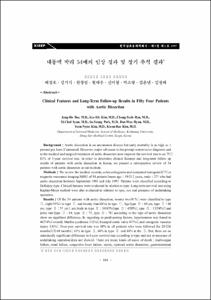KUMEL Repository
1. Journal Papers (연구논문)
1. School of Medicine (의과대학)
Dept. of Internal Medicine (내과학)
대동맥 박리 54예의 임상경과 및 장기 추적결과
- Alternative Author(s)
- Kim, Kee Sik; Kim, Yoon Nyun; Kim, Kwon Bae
- Journal Title
- 한국심초음파학회지
- ISSN
- 1225-6021
- Issued Date
- 1997
- Keyword
- Aortic dissection; Survival rate
- Abstract
- Background:Aortic dissection is an uncommon disease but early mortality is as high as 1
percent per hour if untreated. However, major advances in the prompt noninvasive diagnosis and
in the medical and surgical treatment of aortic dissection now improve the survival rate to an 75–
82% of 5-year survival rate. In order to determine clinical features and long-term follow up
results of patients with aortic dissection in Korea, we present a retrospective review of 54
patients with aortic dissection at our institute.
Methods:We review the medical records, echocardiograms and computed tomogram(CT) or
magnetic resonance imaging(MRI) of 54 patients(mean age:59±12 years, male:27) who had
aortic dissection between September 1991 and July 1997. Patients were classified according to
DeBakey type. Clinical features were evaluated in relation to type. Long-term survival rate using
Kaplan-Meier method were also evaluated in relation to type, sex and presence of undertaking
operation.
Results:Of the 54 patients with aortic dissection, twenty two(41%) were classified to type
Ⅰ, eight(15%) to type Ⅱ and twenty four(44%) to type Ⅲ. Age(type Ⅰ:60 yrs, type Ⅱ:60
yrs, type Ⅲ:57 yrs), sex(male in type Ⅰ:10(45%)type Ⅱ:4(50%), type Ⅲ:13(54%)) and
pulse rate(type Ⅰ:84, type Ⅱ:75, type Ⅲ:78) according to the type of aortic dissection
show no signifiant difference. In regarding to predisposing factors, hypertension was found in
40(74%) overall, Marfan syndrome 1(2%), bicuspid aortic valve 4(7%), and iatrogenic vascular
injury 3(6%). Four-year survival rate was 48% in all patients who were followed for 28±26
months(1-168 months), 61% in type Ⅰ, 44% in type Ⅱ and 44% in the Ⅲ. But, there are no
statistically significant difference in 4-year survival rate according to type and sex or presence of
undertaking operation(data not shown). There are many kinds of cause of death;multi-organ
failure, renal failure, congestive heart failure, sepsis, ruptured aortic dissection, gastrointestinal
*본 논문의 요지는 1997년도 대한순환기학회 추계학술대회에서 발표되었음.
- 16 5 -
bleeding, cerebrovascular disease and postoperative weaning failure in the dead patients from
aortic dissection. And also we found that there are some kinds of cause of death not directly related
with aortic dissection(sepsis, gastrointestinal bleeding and cerebrovascular disease) in patients,
especially in type Ⅲ.
Conclusion:Overall four-year survival rate in patients with aortic dissection was 48% and
there were no significant differences in survival rate accoring to type, sex and presence of undertaking
operation. There were many kinds of cause of death in patients with aortic dissection and
some causes of death was not directly related with aortic dissection. The survival rate in patients
with aortic dissection will be increased by strict control of blood pressure and optimal timing of
operation before development of aortic rupture.
KEY WORDS:Aortic dissection·Survival rate.
- Alternative Title
- Clinical Features and Long-Term Follow-up Results in Fifty Four Patients with Aortic Dissection
- Department
- Dept. of Internal Medicine (내과학)
- Publisher
- School of Medicine
- Citation
- 배장호 et al. (1997). 대동맥 박리 54예의 임상경과 및 장기 추적결과. 한국심초음파학회지, 5(2), 164–171. doi: 10.4250/jkse.1997.5.2.164
- Type
- Article
- ISSN
- 1225-6021
- Appears in Collections:
- 1. School of Medicine (의과대학) > Dept. of Internal Medicine (내과학)
- 파일 목록
-
-
Download
 oak-bbb-05221.pdf
기타 데이터 / 3.29 MB / Adobe PDF
oak-bbb-05221.pdf
기타 데이터 / 3.29 MB / Adobe PDF
-
Items in Repository are protected by copyright, with all rights reserved, unless otherwise indicated.